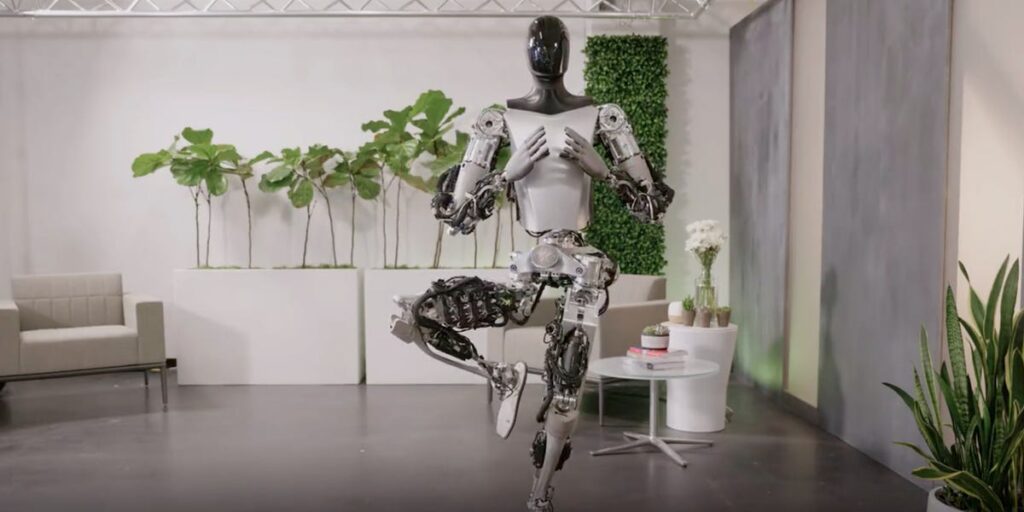Willing to spend hours on end in a motion-capture suit? Tesla is paying up to $48 per hour for the role.
Over the past year, Tesla has hired dozens of workers to train its humanoid robot, Optimus, using motion-capture suits, according to data from LinkedIn.
Elon Musk first announced Tesla’s plans to create a humanoid robot named Optimus in 2021. The Tesla CEO has said the robot will eventually be able to handle jobs ranging from working in a factory to serving as a caregiver.
In June, Tesla said it had deployed two of the Optimus robots at one of its factories. And it appears Tesla has been hiring employees to work alongside the robots as it is developed.
The role, which has the title “Data Collection Operator,” requires workers to walk along test routes and perform designated tasks while wearing a motion-capture suit and a virtual reality headset for more than seven hours per day, according to the job description from Tesla’s Careers page. In addition to collecting data, workers are also expected to analyze the information they’ve gathered, write daily reports on it, as well as work on some minor tasks related to their equipment and its software.
It also has very specific height requirements and calls for people between five foot, seven inches and five foot, eleven inches. Christian Hubicki, a roboticist out of Florida A&M University, said Tesla is likely looking for individuals who will not only fit into the specific suits, but will also have similar sizing to the robot, which Musk has said will clock in around five foot, eight inches.
Tesla is also looking for someone that will be comfortable wearing the motion-capture suit and VR headset for long stretches of time and will be able to withstand some of the disorientation and “VR sickness symptoms” that can come with using the gear for extended periods.
Tesla is hiring full-time workers for the role and is willing to pay between $25.25 to $48 per hour, according to the job listing. The role is available with multiple shifts, including from 8 a.m. to 4:30 p.m., 4 p.m. to 12:30 a.m., and 12:00 a.m. to 8:30 a.m.
Animesh Garg, a senior researcher at Nvidia Research and a robotics professor at Georgia Institute of Technology, said the job likely entails collecting data through simply performing tasks in the motion-capture suit that can be recorded and later analyzed by data annotators in order to train the AI system, as well as tele-operating the humanoid robot directly.
Tesla’s Optimus social media account provided a peek into what the job entails last year.
The video clip shows an operator in a motion-capture suit, with haptic gloves and a VR headset picking up objects while a virtual version of the Tesla Optimus bot performs the same movements.
Earlier this year, Tesla appeared to go on a hiring spree for the role. More than 50 different people have worked in the role over different periods over the past year, according to a Business Insider review of LinkedIn data.
Tesla is likely looking to gather vast amounts of data, experts say.
“It’s the exact same thing they’re doing with Autopilot,” Jonathan Aitken, a robotics expert out of the University of Sheffield, said. “But rather than collecting data from their fleet of cars, they’re paying people to come into the factory or come into a workplace and undertake these tasks.”
Garg, the Nvidia researcher and robotics professor, estimates that Tesla should be aiming to log anywhere from hundreds of thousands of hours to millions of hours of data in order to train Optimus how to work in Tesla’s factories — a feat that could take a lot of time and money.
“It extremely difficult to produce robots at scale,” Garg said, adding that Tesla’s Optimus robots are likely custom built and assembled, as well as constantly undergoing new iterations.
“The amount of data collection you’d need would easily be half a billion dollars and the real question is ‘Even if you do that, do you succeed?’ Because there is no guarantee of success,” he added.
The use of motion-capture suits and tele-operation in robot training is far from a new practice, but Tesla is among the first to attempt to use the practice at this scale and to perform such a wide variety of generalized tasks, according to Aitken.
“In the manufacturing world, we typically have a robot that can do one task really really well, but it doesn’t usually extend beyond that,” Aitken said.
A spokesperson for Tesla did not respond to a request for comment.
Do you work for Tesla or have a tip? Reach out to the reporter via a non-work email and device at gkay@businessinsider.com or 248-894-6012

